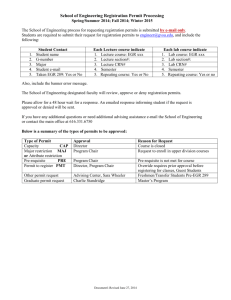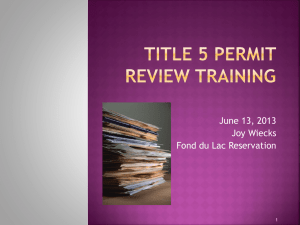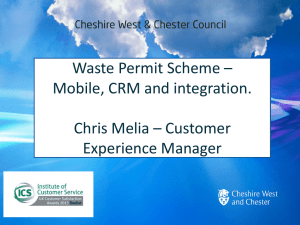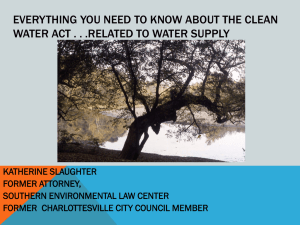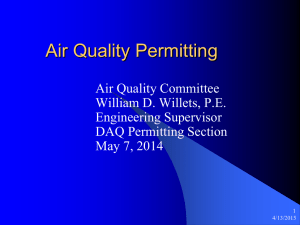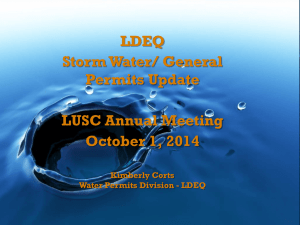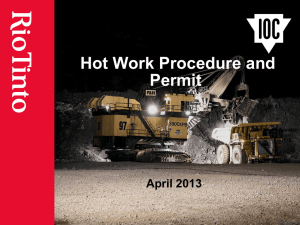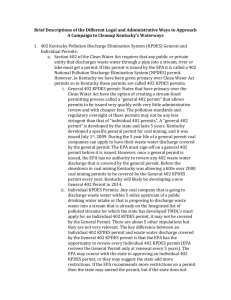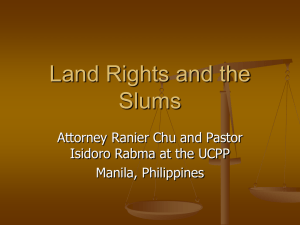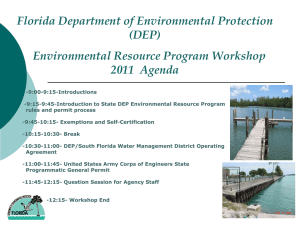Air Quality Permits and Revisions for Industrial Sources
advertisement
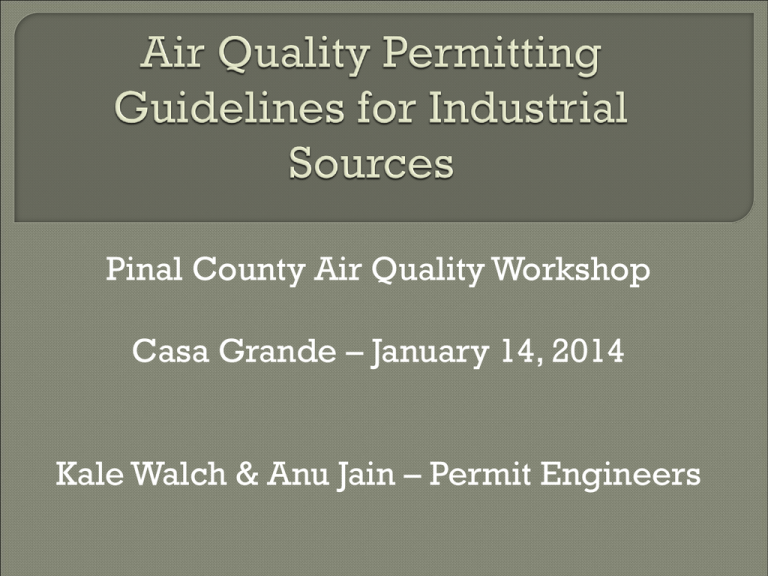
Pinal County Air Quality Workshop Casa Grande – January 14, 2014 Kale Walch & Anu Jain – Permit Engineers Facilities that emit more than 5.5 pounds per day or 1 ton per year of any regulated pollutant. Nitrogen Oxides, Carbon Monoxide, Sulfur Dioxide (NOX, CO, SO2): Usually products of combustion: boilers, heaters, generators… Volatile Organic Compounds/Hazardous Air Pollutants (VOCs/HAPs) Associated with spray paints, solvents, fuels and other organic chemicals. HAPs can also be inorganic: Chlorine, lead and other metals… Particulate Matter (PM10 and PM2.5) PM10, commonly referred to as “dust”: usually from grain/cotton handling, mining operations, general manufacturing… PM2.5 or “fine particles”: can be emitted from industrial combustion, vehicle exhaust, open fires… 1)West Pinal PM10 Nonattainment Area 2012 Moderate PM10 Nonattainment Designation (based on 2006-2008 data) 2013 Stakeholder process to develop the Emission Inventory and propose State Implementation Plan (SIP) components January 2014 the PM10 SIP is due to be submitted to EPA 2) West Central Pinal PM2.5 Nonattainment Area 2011 PM2.5 24-Hour nonattainment designation based on the 2008 three year average 2013 clean data finding based on the 2012 three year average March 2014 a maintenance SIP must be submitted to the EPA Small sources • Area source rules may be incorporated into permits Medium sources • Area source rules may be incorporated into permits • Source might have to take Federally Enforceable limits to stay under 100 tons per year (tpy) Large sources • Nonattainment New Source Review (NNSR) for sources with a PM10 potential to emit (PTE) over 100 tpy • Must install Lowest Achievable Emission Rate Technology (LAER) which does not consider economic impacts • Offsets at a ratio of at least 1:1.1 will be required • Area source rules may be incorporated into permits The purpose of a permit is to identify all the air quality rules your facility is subject to: local (PCAQCD), State (Statutes) or Federal (EPA). A permit also contains air pollution limits for each significant emission source, defines allowable hourly and annual throughputs (e.g., fuel consumption in boilers), and consolidates monitoring, recordkeeping, and reporting requirements. Permits allow you to take certain limitations at your facility to avoid more stringent air quality requirements. Class I Class II Class III Title V sources (above “major source” thresholds) - General sources – rock products. Medium & small spray paint operations Feed Mills Others Small gas stations, auto body shops, dry cleaners… Application Fee (Non-refundable) Permit Processing Fee (not for Class III sources) Annual Fee (invoiced every year) Emissions Fee (only for Class I sources) *Fees for 2014 are posted on our website. *Some fees are adjusted annually by the Consumer Price Index (CPI). Permits valid for 5 years. Letters to renew permits sent at least couple of months before the permit expiration date. Revisions do not start the clock. You will need to submit: 1) Permit Application 2) Additional Forms for Fuel Burning equipment, 3) Fill-in-able Forms available at http://www.pinalcountyaz.gov/Departments/AirQ uality/Pages/IndustrialPermits.aspx Storage Tanks, Crushing and Screening equipment, Cotton Gins, Generators, Soil Vapor Extraction Units, Spray Paint Booths and Wastewater Treatment Plants. 4. Follow filing procedures under: “Generic Outline or Air Quality Permit Filing Instructions” Information required includes but not limited to: process description, site plan, flow diagram, plant and equipment capacities, MSDS sheets… http://pinalcountyaz.gov/Departments/AirQuality/Pages /Industrial Permits.aspx 4) TIME FRAMES Form Dear applicant, As part of your application package and to ensure timely service, Pinal County Air Quality Control District would appreciate if you could indicate below when you will require the issuance of your permit. Below are our average time frames for issuing of industrial permits. These time frames include a mandatory 30-day pub lic notice, an additional 45-day EPA review for Class I permits, permit processing time, and administrative time (invoicing, issuance of permit, etc…) Class III: Small gas stations, auto body shops, dry cleaners, small fuel burning and/or generators – 60 to 90 days Class I Title V – 120 to 300 days Class I NSR/PSD – 180 to 300 days Class II: Other facilities that do not fall under any of the categories above – 60 to 200 days CONTACT PERMITTING STAFF FOR MORE SPECIFIC TIME FRAMES FOR YOUR FACILITY. THESE TIME FRAMES WILL NOT HOLD IF THE APPLICATION IS NOT COMPLETE. INCOMPLETE APPLICATIONS MAY REQUIRE ADDITIONAL PROCESSING TIMES. IF THE PUBLIC REQUESTS A PUBLIC HEARING, THE TIME FRAMES MAY INCREASE BY 30-90 DAYS. COMPANY: ______________________________________________________ APPLICANT NAME: ______________________________________________________ TITLE: ______________________________________________________ REQUESTED PERMIT ISSUANCE DATE (MONTH/YEAR): _________________________ SIGNATURE: __________________________________________ DATE: _________________ TYPES: Permit Revision: Changes in equipment, process, products. Permit Transfer: Ownership change. Same application form as for “New” permits, but check “Revision” box. Same information needed as for “New” permits, but only in relation to changes and or modifications. Revision application fee applicable to Class I permits only. Use same Application form but check “Transfer” box. No processing fee associated with transfers. Apply before the transfer occurs. Mandatory Public Notice period of 30 days for new permits, revisions and renewals. Class I and some large Class II permits have a Mandatory EPA review period of 30-45 days. Permit processing time depends on the complexity and the completeness of the application. Some recent standards (subparts): 6H’s – Paint Stripping and Miscellaneous Surface Coating (INCLUDES Autobody shops) 6W’s – Plating/Polishing 6X’s – Metal Fabrication/Finishing 6Z’s – Aluminum, Copper and other non-ferrous Foundries 7C’s – Paint Manufacturers 7D’s – Prepared Feed Manufacturers. 4Z’s (RICE) – Diesel and Natural Gas Engines. Each one contains a specific Compliance Date. Must submit INITIAL NOTIFICATION. Brochures available at www.epa.gov/ttn/atw/area/arearules.html For new sources subjected to Pinal County’s permitting thresholds an air quality permit is required before starting construction or operation. For current permit holders a revised permit is required before any modifications or changes*. *When in doubt call Kale Walch, Senior Permit Engineer (520) 866-6860 kale.walch@pinalcountyaz.gov Anu Jain, Permit Engineer (520) 866-6931 anu.jain@pinalcountyaz.gov Biomass Boilers • July 20, 2011 EPA deferred the application of PSD and Title V to CO2 • • • • • emissions from bioenergy until July 21, 2014 July 12, 2013 the U.S. Court of Appeals vacated the deferral Vacatur becomes effective 7 days after the deadline for rehearing motions passes August 26, 2013 the court extended the appeals deadline October 15, 2013 the Supreme Court agreed to review limited greenhouse gas issues Granted review over an issue involving the statutory trigger for GHG permitting October 22, 2013 a motion was filed asking the court to extend the deadline for rehearing petitions to 30 days after the Supreme Court issues its decision November 14, 2013 Court of Appeals granted the extension Next steps?????????? Counting GHG Fugitive Emissions in permitting applicability (12/12/13 guidance, http://www.epa.gov/nsr/ghgqa.html ) • Generally, GHG fugitive emissions are counted the same as other pollutants • For determining whether a source is a major source fugitives are not included unless the source is a listed source. Once it is determined that a non-listed source is major for at least one regulated NSR pollutant based on non-fugitive emissions, fugitive emissions are then included in all subsequent analyses (i.e. significant emission rates, BACT, air quality impacts) • For modifications under PSD fugitive emissions are included in determining a physical or operational change is a major modification, regardless of source category
